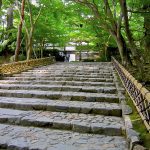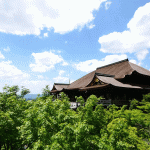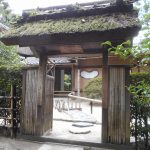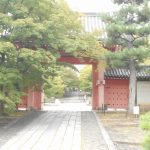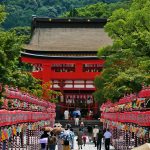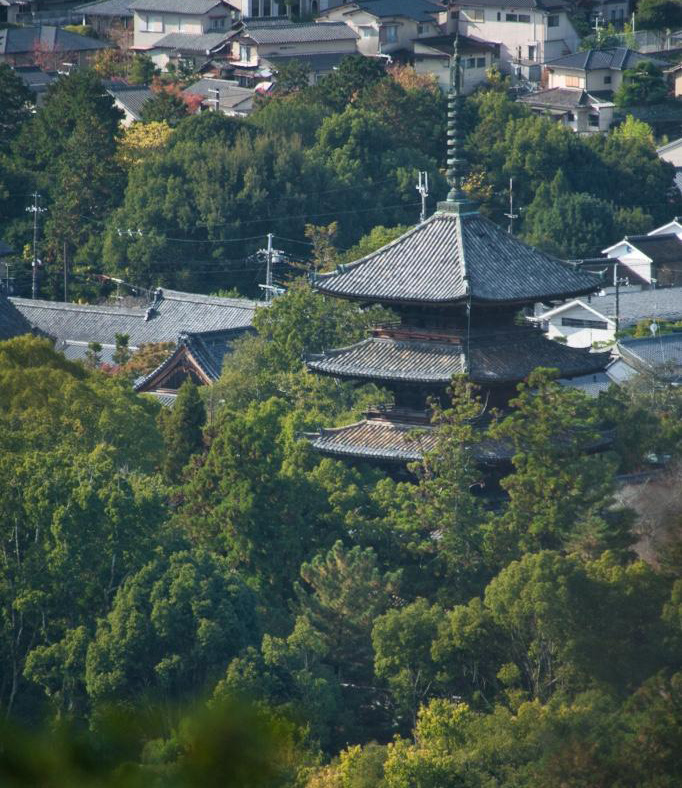
ページの目次
- Ninnaji Temple(仁和寺)
- 1. Location-Access
- 2. Who was built this temple?
- 3. What is this temple famous for ?
- 4. What is highlight?
- 1) 拝観ルート Visiting Rute(1 hour)
- 2) 二王門(重要文化財) Niou-mon (Important Cultural Property)
- 3) 御殿(国宝) Goten (National Treasure)
- 4) 中門 (重要文化財) Chumon (Important Cultural Property)
- 5) 五重塔(重要文化財) Five storied pagota (Important Cultural Property)
- 6) 金堂(国宝) National Treasure (National Treasure)
- 7) 御影堂(重要文化財) Mikage-do (Important Cultural Property)
- 8) 茶室、遼廊亭、飛濤亭(重要文化財) Tea ceremony(Important Cultural Property)
- 9) 御室桜 Omuro-zakura
- 10)世界遺産 Was made a World Heritage Site in 1994.
Ninnaji Temple(仁和寺)
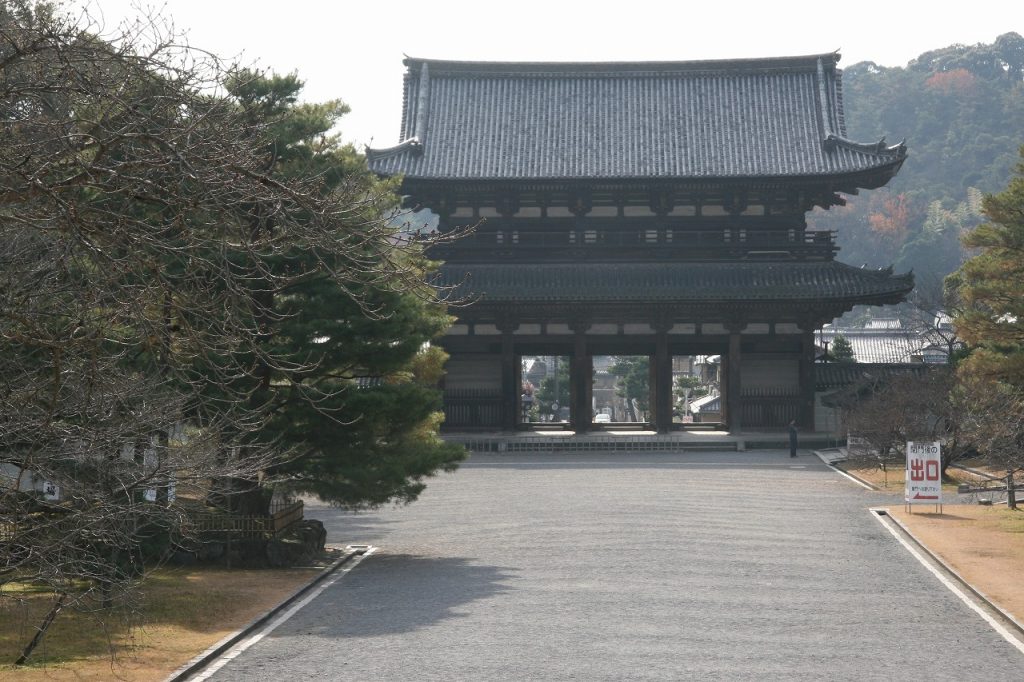
1. Location-Access
This tenple is located in Rakuhoku Area to the North/South of Kyoto.
We take about 40 minutes from Kyoto station to Uzumasa station by JR railway,
and satueisyo-mae to omuroninnnazi by Keifuku railway.
(この寺は京都北西部洛西エリアに位置する。
JRで京都駅から太秦駅、京福電車で撮影所前から御室仁和寺、で約30分かかる)。
2. Who was built this temple?
1) This temple was begun by Imperial request and was completed in 888 under Emperor Uda. (この寺は888年に宇多天皇により完成した勅願寺である。)
2) Ninnaji-temple became the foremost monzeki0jiin. Monzeki-jiin was a temple who abbot was an Imperial Prince or other number of the Imperial Family.
So it was also called the “Omuro-gosho” (Imperial Palce).
(仁和寺は筆頭門跡寺院となった。門跡寺院とは、僧院長が皇子・皇室である寺のことである。だから「御室御所」と呼ばれた。)
3) It was destroyed by fire during the “Ounin-no-lan”(1467-77)wars, but was rebuilt 1641-44. For this restoration, the Shishiden (main hall) and Tsune-goten (private palace) of the Gosho (Imperial Palace) were relocated to Ninnaji Temple.
They respectively became the Kondo and Ninnaji Goten, which was destroyed by fire in 1888.
(応仁の乱(1467-77)により、火事で焼失したが、1641-44年に再興された。当時、御所に在った紫宸殿と常御殿が移築されて、それぞれが金堂、御殿に転用せれた。)
4) Other building in the temple are the Miekage-do, which was built of wood used in the Seiryoden building, a part of the Imperial Palace, Niou-mon (Deva gate), the Chu-mon (middle gate) and the Gojuno-tou (five –storied pagoda).
The Majority of Ninnaji building started from this 17th century restoration.
(また、清涼殿の古材を用いて御影堂が通営された他、二王門、中門、五重塔などが建てられ、17世紀頃から場内の整備が進められた。)
3. What is this temple famous for ?
1) There are Kondo(National Treasure) and Gojuno-tou(Important Cultural Property) in this temple. ‘Goten Palace is Gosho style architecture and has Heian Dynasy Culure drifts.
(境内には金堂(国宝)、五重塔(重要文化財)があり、御殿は御所風建築で、平安王朝文化が漂う。)
2) This temple is famous for late blooming cherry blossoms in spring and Autumn leaves.
(春は遅咲きの御室桜、秋は紅葉で有名である。)
4. What is highlight?
1) 拝観ルート Visiting Rute(1 hour)
Niou-mon(Deva gate) → Goten → Chu-mon(middle gate) →Goju-no-tou(five-storied pagota)→ Kusho-myojin → Kyodo → Kondo → Toro → Mikage-do →Mizukake-fudouson → Daikokudo → Goten.
(二王門 → 御殿 → 中門 →五重塔→ 九所明神 → 経堂 → 金堂 → 桜楼 → 御影堂 →水掛不動尊 → 大黒堂 → 御殿).
2) 二王門(重要文化財) Niou-mon (Important Cultural Property)
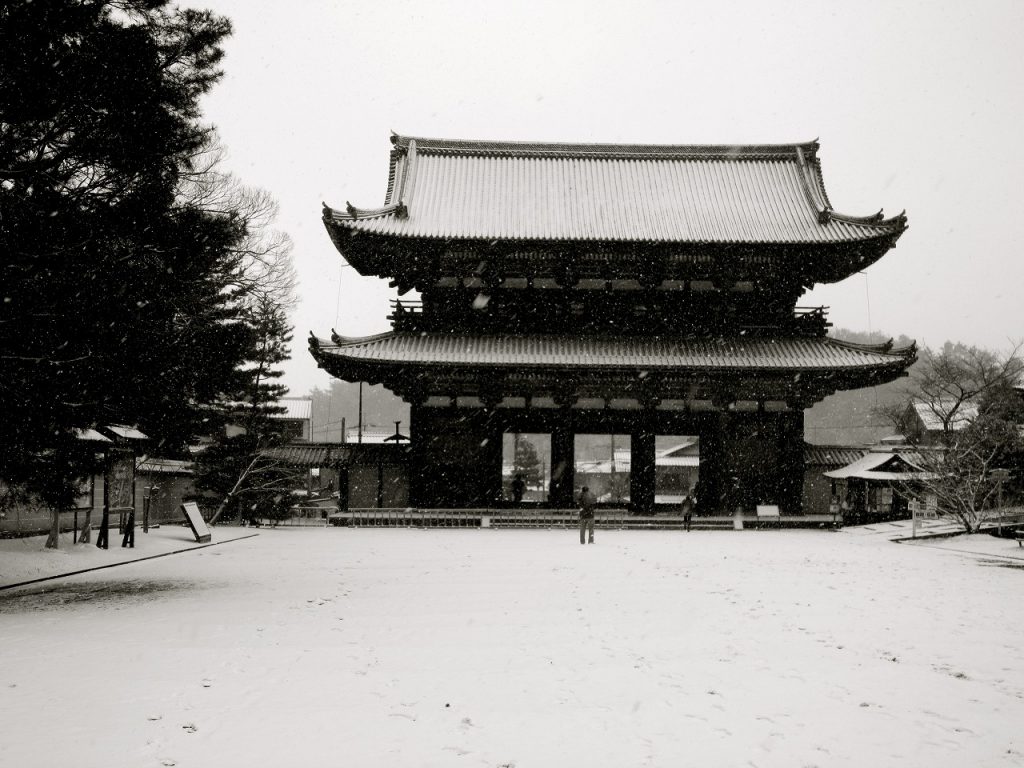
What a big gate! This temple has a lot of eye-catching buildings like this Niou-mon gate and five-storied pagoda. It was built in 1645 and the height is 18.7m.
In this time, the Sanmon, large triple gate of Nanzenji, Chionin and Ninnaji were built.
First two were constructed in Zenshu style, others in Heian style.
(大きな門ですね!仁和寺には、二王門や五重塔など目を引く建物が多い。1645年に建立されたが、前二門は禅宗造り、仁和寺は平安様式であった。)
3) 御殿(国宝) Goten (National Treasure)
Let’s go inside. The gates and buildings have a somewhat elegant look. This temple has a lot to do with the Imperial Family. This is where Emperor Uda lived and composed of Shinden, Kokusho-in, Hakusyo-in with Gosyo type architecture style.
(さあ、入ろう! 境内にある門や建物はどこか優雅な感じがある。皇室にもゆかりが深く、宸殿、黒書院、白書院からなり御所風建築である。)
4) 中門 (重要文化財) Chumon (Important Cultural Property)
Middle gate is the second gate of Ninnaji-Temple, lacated straight from Niou-mon.
It was built vermilion gate in early Edo period, 17 century.
(仁和寺の二王門から入って直進した先に位置し、仁和寺伽藍の第二の橙色の門で17世紀に創建された。)
5) 五重塔(重要文化財) Five storied pagota (Important Cultural Property)
A representative pagota of Kanei era and was built 1644 with 36 m height.
This pagota has the same roof size from Ist storey to the top. The inside of primary storey on first floor, the statues of Five Great Kannon, with Dainichi kannon at their outer.
(寛永年間を代表する塔で、1644年建立され、高さは36mである。この塔の特徴は、初層部から最上部まで屋根の大きさが均一である。内部は、大日如来、周りに四方仏が安置されている。)
6) 金堂(国宝) National Treasure (National Treasure)
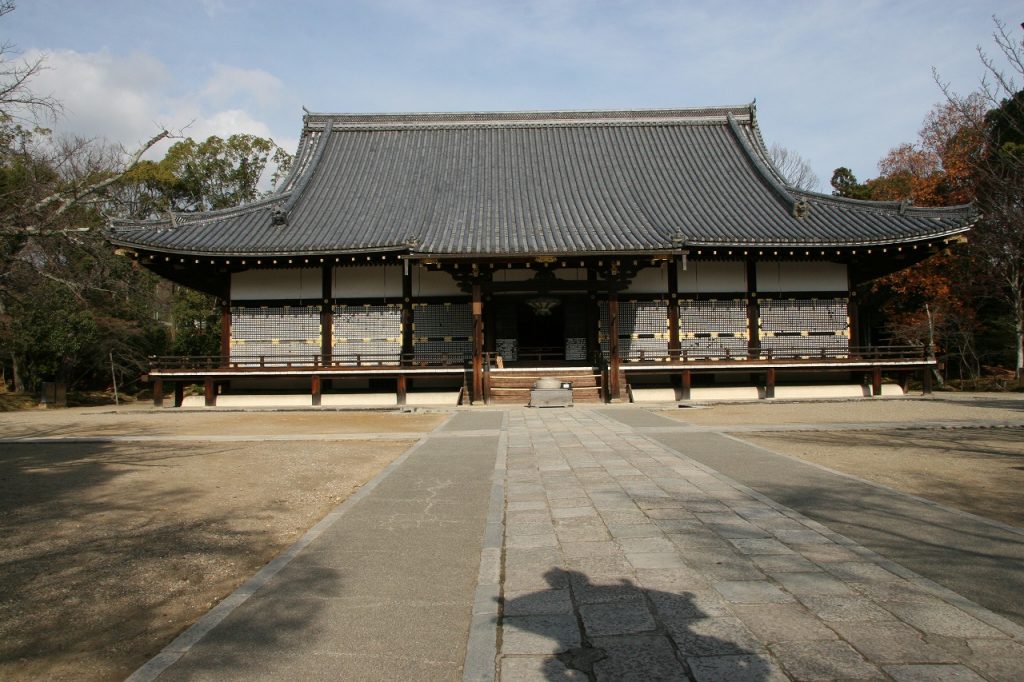
Kondo is a transfer of the Imperial Palace in 17 century(1644), and is the oldest existing Shishinden. The prestige Amida triad, Shitennou statue and Braha statue is enshrined at Kondo.
(17世紀に御所の紫宸殿から移築したもので、現存する紫宸殿では最古である。金堂には、阿弥陀三尊、四天王像や梵天像が安置されている。)
7) 御影堂(重要文化財) Mikage-do (Important Cultural Property)
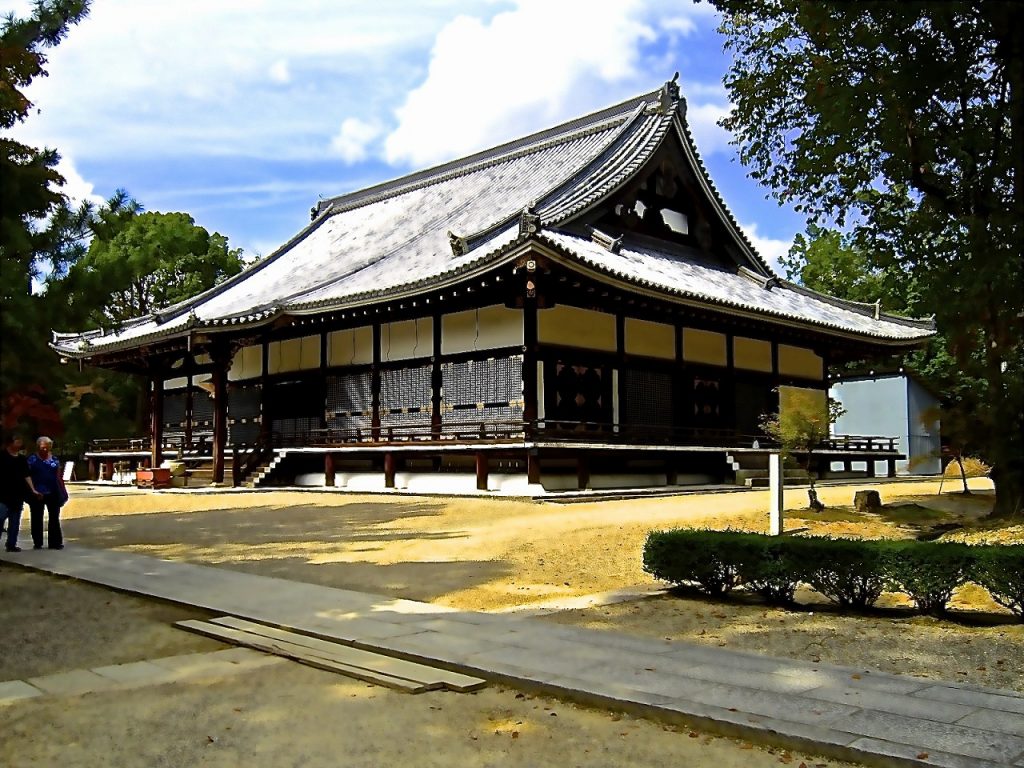
In 1645, Mikage-do was relocated from a part of Seiryoden of Gosyo.
(1645年、旧御所の清涼殿の一部を移築させた。)
8) 茶室、遼廊亭、飛濤亭(重要文化財) Tea ceremony(Important Cultural Property)
There are only existing tea ceremony in this temple with skiya style of building.
(仁和寺にある唯一存在する数寄屋造りの茶室であり、双方の茶室とも御殿の奥にある。)
9) 御室桜 Omuro-zakura
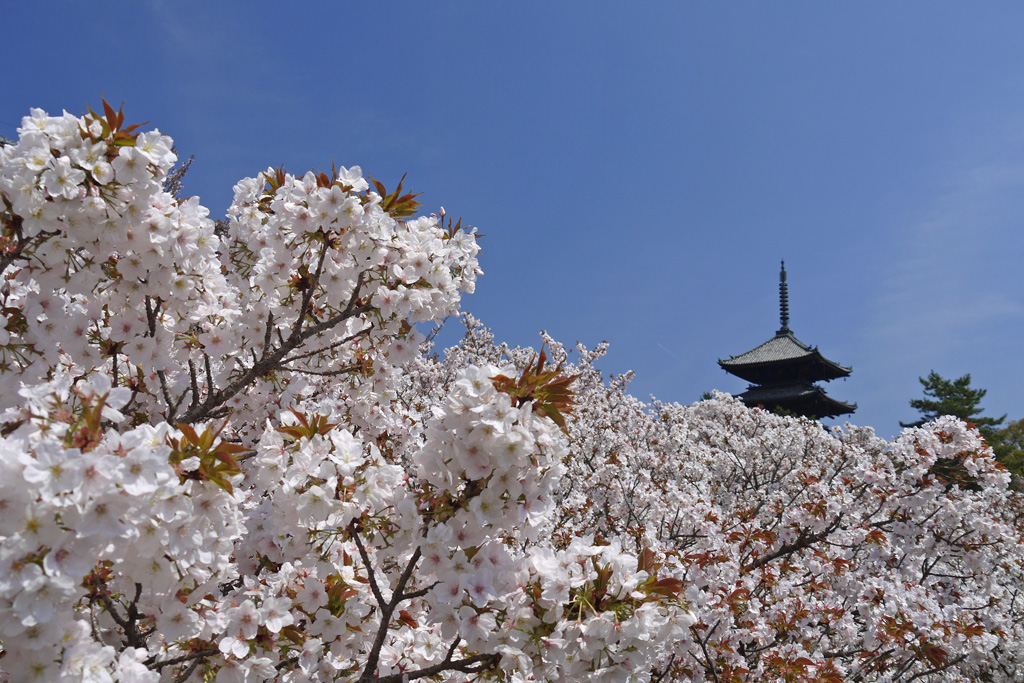
Do you know anything about Omuro-zakura in this temple?
They are cherry trees with height of two to three meters. Because they are short, you can enjoy the beautiful blossoms. They usually bloom late to mark the end of the cheery bloossom season of Kyoto.
(境内にある「御室桜」を知っている?高さ2-3mの桜なんだ。背が低いから間近に美しい花を楽しめる。遅咲きで、京都の花見シーズンを締めくくる。)
10)世界遺産 Was made a World Heritage Site in 1994.
Was made a World Heritage Site in 1994.
(1994年に世界遺産に登録された。)

